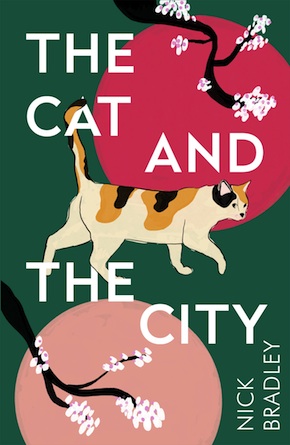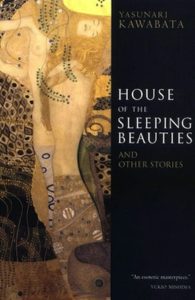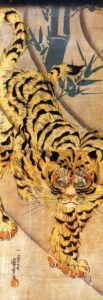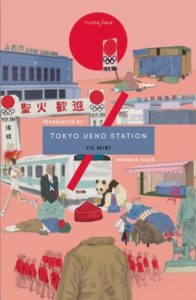Nick Bradley: Tokyo calling
by Mark ReynoldsNick Bradley’s debut novel The Cat and The City offers a dizzying ride through the underbelly of a Tokyo normally invisible to outsiders. Artfully combining different styles of popular storytelling – from horror, Sci-Fi and fantasy to detective fiction and even manga – the lives of a disparate band of characters are deftly intertwined. A tattooed temptress, a convenience store worker, a homeless alcoholic squatting in an abandoned capsule hotel, a would-be literary translator putting in a shift for the Tokyo Olympics, a postman, a taxi driver and an agoraphobic video gamer are each pursued or observed in their daily comings and goings by a distinctive green-eyed calico cat. We chatted on email about his inspirations, ambitions – and passionate dislike of pigeonholing by genre.
MR: You initially went to Japan for a gap year, and it wound up being your home for a decade. Why did you choose Japan?
NB: The answer to this is a little surprising: I really don’t know why I picked Japan. To be honest, the rationale behind the move was that I’d just finished my master’s and I was lining up to do a PhD, but I had this voice inside my head telling me that if I wanted to be a writer I should move to another country, travel, experience life, learn another language and get into some adventures, and that all of this was going to be vital to writing fiction. This was originally just going to be for one year, but I ended up getting sidetracked by the Japanese language. I fell in love with it, and I spent hours each day studying, often writing out up to 2,000 kanji characters a day in my practice book. To the result that I moved into translation. After working for a number of Japanese companies, I was suddenly gripped with the realisation that I’d become a full-time translator and a part-time writer. So I began the journey of getting back into the world of literature.
What kinds of culture shock did you experience on arrival and/or during your stay?
Oh gosh… It was so long ago that I struggle to remember the first impressions I had on going to Japan, and the country actually feels very much like a second home to me now. In some ways, it was quite easy and natural to fit in when I first went there. What I found harder was the reverse culture shock of coming back to Britain with massive gaps in my pop-culture knowledge, not knowing this famous person or that huge cultural event, things like that. Settling into Japan was actually a much easier experience than returning to a place I thought was home and familiar, but which had changed so much in both my mind and reality while I was away.
How much Japanese literature had you read ahead of that trip, and which Japanese authors do you particularly admire?
Sadly, I don’t think I’d read any (although I was massively into world cinema back then and had watched a great deal of Japanese films – I even thought about writing something on Koreeda Hirokazu for you…) It was once I got to Japan that I started to read Japanese authors widely. My favourites? Lots of them, but I’ll list a few here: Tanizaki Jun’ichirō, Natsume Sōseki, Kanehara Hitomi, Murakami Ryū, Yoshimoto Banana, Kawabata Yasunari, Abe Kōbō. I’d say Mishima Yukio is an author I have a love/hate relationship with – he’s a difficult character indeed. Obviously, I’m going to say the other Murakami, too. His (early) books had a massive impact on me when I first moved to Japan.
I ended up getting sidetracked by the Japanese language. I fell in love with it, and I spent hours each day studying, often writing out up to 2,000 kanji characters a day in my practice book.”
How long was it before you attempted reading a novel in the original Japanese, and which was it?
I think (although it was a long time ago) it was a collection of Sci-Fi short stories called Bokko-chan by Hoshi Shin’ichi. This was about a year into my studies, or so. I remember also at the same time reading Murakami’s first novel Hear the Wind Sing. I distinctly remember photocopying the small Japanese paperback book, enlarging it slightly so that I could highlight new vocabulary and underline bits, and add annotations. When I first moved to Japan, I had only a small paper dictionary, which I thumbed through so much in the heights of humid summer it developed a dirty brown stain on the side. Getting my first electronic dictionary in a Japanese tech shop was one of the best days of my life!
How many of your favourite Japanese novels or stories make an appearance in The Cat and the City? (The Tale of Genji and House of the Sleeping Beauties spring immediately to mind…)
I’m really glad and impressed you picked up on the House of the Sleeping Beauties reference! Which, incidentally, is one of the most fantastic/creepiest/weird stories I’ve ever read! (Everyone should read it!) I’m going to be sneaky though and decline to answer precisely which other novels and stories are referenced in the book – I’ll leave it to readers to spot those (in the same way as all the tiny links between the chapters). There are quite a few though, and there are lots of clues!
Is Nishi Furuni and his ‘Copy Cat’ cloning story based on a particular Japanese writer, or is he an almalgam?
I’d say he’s part amalgam, part my own invention, but, you can probably guess from the earlier reference to the real-life Sci-Fi writer Hoshi Shin’ichi (星新一) that he has a slightly similar name to Nishi Furuni (西古二). In fact, there’s a clue in the Japanese for his first name – Nishi means ‘west’ but rhymes with Hoshi (which means ‘star’). Shin’ichi means literally ‘New One’ while Furuni means ‘Old Two’. Gosh, it makes me feel a bit naked showing my hand here, so to speak!
At what point in the writing did you decide to switch between popular genres in the telling of your story? Was ‘Copy Cat’ among the first parts you wrote?
Firstly, ‘Copy Cat’ was not one of the first parts – if memory serves correctly, it was about 60-70% of my way through writing the book. Secondly: genres. OK, here’s where I get to rant a bit. I hate the division in the reading world between genres. I constantly argue with anyone who will listen that I don’t see WHY we divide fiction up into sub-categories. I’m sure a lot of readers will disagree with me (and there are plenty of excellent arguments against what I’m saying), but I’ve always fantasised about a library or a bookshop where you walk in and a big sign just says FICTION, and everything is filed away from A to Z. In my extreme moments, I even want to file NON-FICTION away under the FICTION section, too. However, if I was feeling charitable, I’d allow for the two categories to be distinct. But back to the question: I’ve always loved writers who play around and experiment with all genres, and I wanted to write a book which contains as many of those as space would allow, so I’ve tried to include Sci-Fi, Crime, Ghost Story, Realism, Translation, Manga, Photography, etc., etc. I just wanted to write a book that celebrates all forms of storytelling. /rant over/
Which of the interrelating characters came to you first?
Other than the cat? The cat was definitely the first character to appear. But in terms of the human cast, the first chapter I wrote was ‘Omatsuri’, so it would be Sachiko, in the bath, looking forward to the festival that evening.
You recently completed a PhD focusing on the figure of the cat in Japanese literature. In brief, how and why has the cat become such a strong emblem in both literature and general Japanese culture?
Excellent question! I’ll try to be as brief as possible (because the answer is long and complicated). Cats were not indigenous to Japan, and were introduced to the country with Buddhist scriptures from mainland Asia via China and Korea. The cats were taken onboard ships to protect the Buddhist scriptures from being eaten by rats and mice. They were subsequently taken to the temples with the scriptures, which brought about a trend of folk tales involving the relationships between priests and cats.
At the same time, cats were prized by members of the court (and there’s a famous cat in The Tale of Genji who is a major causal factor in one of the storylines). This particular incident was the subject of many illustrated versions of Genji which popularised its depiction of the cat in art. Then we have the cat-crazed ukiyo-e artist Utagawa Kuniyoshi, who was obsessed with painting cats. It could be argued that the introduction of the cat into the highest echelons of both the religious and the courtly worlds gave it the air of an animal to be revered.
But really (in my mind), the genesis of the modern Japanese cat novel began when Natsume Sōseki returned to Japan in 1903 (after a terrible couple of years studying British Literature in London). He wrote a satirical short story for the literary magazine Hototogisu (Cuckoo) called ‘I Am a Cat’ which was so popular it became a regular serialisation, later a novel, and launched his career as the godfather of modern Japanese novelists. He had a couple of disciples who also wrote cat books as a form of homage. Phew! Sorry – I could talk about this for hours. For those interested, google the word nekonomics.
Can you judge a society by the way it treats its cats?
I think so. I know it’s an extreme statement, but it’s similar to the idea of judging a society on the way it treats its prisoners. A good society takes care of everyone with compassion and respect – regardless of who they are.
How much of the book was planned or written before you moved back to the UK to take the Creative Writing MA at UEA? And how did that course help shape the novel?
None of it at all, although I’d written an aborted novel while living in Tokyo which featured a tiny cameo by a cat, but it was a completely different idea. Before coming back to the UK I actually wrote another novel set in Japan (100,000 words) before starting the MA at UEA. I put it in a drawer and decided to experiment and write new material while doing the MA. For my first workshop, I put in the first chapter of another novel I wanted to write (a Sci-Fi novel about a cult, which people sort of smiled at and looked a little concerned). I had planned to not write about Japan, but after I met with my workshop leader for a tutorial and he heard about everything I’d done in Japan, on his advice I wrote the festival chapter, and from the response I got in the workshop I saw that this was something I should pursue. So I continued to work on this novel throughout the whole MA. The MA was an incredible experience for me – the chance to experiment with ideas and forms, and to meet other people who wanted to be writers and learn from them. My tutors were all brilliant and full of excellent advice as well. I never went back to the other novel in the drawer, and that is where it shall stay forever!
Big cities are strange places, which offer so much in ways of culture and excitement, but most people who move there can’t enjoy those things because they’re juggling stressful jobs, and trying to pay inordinate rent.”
The Tokyo you depict is challenging and unforgiving. What are the biggest obstacles facing strangers to the city from within Japan – and how does that compare with the gaijin experience?
Another very good question! I first lived in rural Japan (and even in the UK, I’ve never lived in London), and I absolutely loved my life there – I didn’t get any decent fiction out of it, but I really enjoyed my time there. When I was moving to Tokyo, you must remember that I wasn’t a stranger to Japan, and was fluent in the language (albeit I spoke a dialect, which I had to correct to standard Japanese) but I suppose similar to any provincial person moving to a big city, or the nation’s capital, some of us are never prepared for that big city culture shock. The Japan I had known – where kindly colleagues brought in big bags of mikan oranges, persimmons and rice they’d grown in their gardens and fields, where they’d invite me over to dinner at their houses to meet their families – that Japan was a million miles away from life in Tokyo, where we all lived in tiny apartments and only congregated in cramped restaurants and bars after work.
I think everyone who has moved to the big city in search of a dream has had that feeling. Big cities are strange places, which offer so much in ways of culture and excitement, but most people who move there can’t enjoy those things because they’re juggling stressful jobs, and trying to pay inordinate rent. And often there is a culture of having to pretend that one is an old hand – I know the city inside out, why don’t you? And that sentiment lends itself to a coldness and isolation that we all feel, but can’t admit to in public. Ironically, the friendliest people in the big cities are the ones who were born and grew up there. It’s the outsiders who move to the city who feel they need to act like a cosmopolitan city-dweller who perpetuate that cold indifference.
You describe the city’s clean-up ahead of hosting the Olympics, and its effect of moving on the homeless from the city parks. What is the upside of opening up the city to a huge wave of foreign visitors and media?
So, the cleaning up of the city was something I’d read about that happens in ALL Olympic cities, so I certainly wasn’t pointing the finger at Japan/Tokyo. The one issue that a group of Japanese people DO feel though, is whether it was the right time to host the Olympics. Following the 2011 Tohoku Disaster, there were still many things that needed attention, and many people felt angered at the move to host the Olympics, having not resolved issues already. It’s a tough one – there are so many arguments for and against these kinds of questions. Returning to fiction though, I believe this is the one great thing about fiction: it can present an issue to a reader, without telling them what to think. Fiction operates in the grey area, where there is no black and white. Understandably so, because art imitates life, and life is complicated. On a side note, I only just read this book last month, but was alarmed at the similarity to the second chapter of The Cat and The City and the themes it explores, but anyone interested in these ideas should definitely read Yu Miri’s Tokyo Ueno Station.
Your closing chapter is timed during the 2020 Olympics’ opening ceremony. Are there any thoughts to move the action on by a year for the paperback edition since the games were moved after the hardback went to press, or does that inconvenience not bother you?
I’m not sure what to do about this. I’m thinking I might just leave it as it is. I might ask my publishers if I can write a little afterword dealing with this for the paperback release, but I haven’t decided yet. In some ways, it makes the book slightly more interesting as it is – and similar in spirit to Murakami’s 1Q84 in that it becomes an imagining of an alternate-reality Tokyo. The what-if-it-hadn’t-happened? 2020.
Do you have a sense of how Japan has fared during the Covid-19 crisis, compared to the UK and elsewhere?
I couldn’t say for sure, as I’m not there now. I hear from my Japanese friends that the impression in Japan is that the UK is not doing so well. And I’m sure that life for me in a provincial UK city right now is very different to the experience of Londoners. Even within the UK alone, the pandemic has been an entirely different experience for all of us individually. But honestly, I’ve become slightly wary of these national comparisons of which country has done better or worse. The way I see it, we should all be in this together – it is after all a global pandemic. Coming back to societies and cats – we all have to look after each other right now, and forevermore.
Do you have other Japan stories up your sleeve, or will your next fiction take a wholly new direction?
I think I might be one of those writers who doesn’t like to talk about their next project, so I’ll keep quiet about this one for now. All I will say is that having finished with the PhD now, I’m so glad I can immerse myself in writing fiction again. It really brings me pleasure.
Are there any plans afoot for a Japanese edition of The Cat and the City?
As of now, there’s Italian, French, Chinese, Bulgarian and Czech, but I’m very much keeping my fingers crossed, and praying to a maneki-neko effigy for a Japanese translation. I’d love for my Japanese friends to be able to read my book, and for them to know how much I love them all, and miss them.
 Nick Bradley was born in Germany in 1982 and grew up in Bath. After graduating with a master’s degree in English literature, he lived and worked in Japan on and off for ten years before returning to England to attend the Creative Writing MA at UEA, graduating in 2016. A fluent Japanese speaker, he recently completed a PhD funded by the Great Britain Sasakawa Foundation in Creative & Critical Writing at UEA, focusing on the figure of the cat in Japanese literature. He lives in Norwich. The Cat and The City is published in hardback and eBook by Atlantic Books.
Nick Bradley was born in Germany in 1982 and grew up in Bath. After graduating with a master’s degree in English literature, he lived and worked in Japan on and off for ten years before returning to England to attend the Creative Writing MA at UEA, graduating in 2016. A fluent Japanese speaker, he recently completed a PhD funded by the Great Britain Sasakawa Foundation in Creative & Critical Writing at UEA, focusing on the figure of the cat in Japanese literature. He lives in Norwich. The Cat and The City is published in hardback and eBook by Atlantic Books.
Read more
nickbradleywriter.com
@nasubijutsu
Mark Reynolds is a freelance editor and writer, and a founding editor of Bookanista.
@bookanista
wearebookanista





